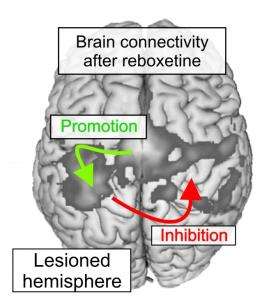Improving post-stroke rehabilitation with neurotransmitter

In many patients, fine motor skills remain impaired after a stroke. A recent study has shown that the neurotransmitter noradrenaline may be able to reduce such deficits. This finding could result in the development of a new therapeutic approach to the post-stroke rehabilitation of patients.
As part of the study carried out by Christian Grefkes from the Max Planck Institute for Neurological Research in cooperation with scientists from the Institute of Neurosciences and Medicine of the Forschungszentrum Jülich and the Department of Neurology of the University Hospital of Cologne, eleven stroke patients (between 42 and 74 years old) with fine motor deficits carried out a range of motor tasks which involved the determination of maximum grip power and finger-tapping frequency and the execution of pointing movements.
The researchers influenced the dwell time of the naturally released neurotransmitter noradrenaline by administering reboxetine (RBX) to the patients. This substance slows down the reuptake of the transmitter by neurons and hence extends its stimulating effect on coupling within the cortical motor network. As a control condition, some patients were given a pill that looked the same, but contained no active substance (placebo).
On the behavioral level, the extended dwell time of the noradrenaline prompted an improvement in the patients’ performance of simple motor tests: while grip power in the affected hand increased by a factor of four on average, the finger-tapping frequency doubled – this represents a remarkable improvement from both the patients’ and neurologists’ point of view. As indicated by functional magnetic-resonance imaging scans (fMRI), the improvements in motor performance were associated at cortical level with a normalisation of the previously abnormally increased brain activity – particularly in the motor areas of the damaged brain hemisphere. These processes were accompanied by greater communicative efficiency between the hand area and the brain’s motor control centers.
Max Planck junior scientist Christian Grefkes is optimistic about the results: “The findings of our study could provide a starting point for the development of a promising new therapeutic approach to the correction of defects in brain networks and improvement of hand motor functions following a stroke”. The plan is now to test reboxetine on a larger group of patients over a period of several weeks to establish the sustainability of the improved effects.
More information: Ling E. Wang, et al. Noradrenergic Enhancement Improves Motor Network Connectivity in Stroke Patients. Ann Neurol. 2010 Dec 28; DOI:10.1002/ana.22237















